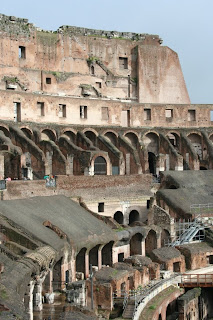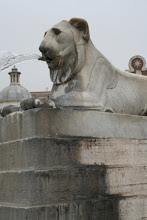

There’s a tendency to cosy on up indoors when it’s chilly outside, and especially when it’s raining. We have to remind ourselves today that we’re in Rome and we need to get out and about.
Shirley, my visitor is looking for some boots that are comfortable enough to handle the cobblestones. We try a few in the vicinity – there are 5 shoe stores in the Via Guibbonari alone – and have some success. Quick boot change back at the apartment and we head down past the Fountain of the Turtles and the Theatre of Marcellus, over the Capitoline Hill and on to the Colosseum.
It’s such an impressive sight as it looms up, a stadium once capable of seating 55,000 spectators and providing access to the many different levels of social stratum; plebs and women at the uppermost level, and senators centre stage of the action. The massive arches are now mostly stripped of their travertine marble and showing the bare tufa stone of the original construction. The many holes and pits in the stone show the marks of the pulleys used to level the massive blocks into place.
Outside the Colosseum latter-day gladiators and centurions are touting for business. We wonder to each other what it must be like to don the breastplate and helmet before heading off to work each day. Presently, there’s not much custom to be had as the crowd hurries on through the cold to the relative warmth of the ticket office.
Inside, we wait by the third arch as instructed for our English-speaking guide. She collects us, her only two patrons, and we turn and face the outer wall and listen while she explains how the Emperor Vespasian held a hundred days of festivities when the Colosseum was officially opened in 80 AD. She tells us to look for the ancient roman numerals on the outside walls, depicting the correct entrance gate for the token-holder. She also tells us about the gladiators, and how they trained hard in either state or private fight schools to learn how to use every weapon from the sword to the lasso.
On the upper level we stand at the best vantage point and look down at the exposed underground tunnels where the animals were kept, ready to be levered up to the stage via a number of trapdoors. This is what grabs at the heart and it distresses me to hear the scale of the carnage. Hard to equate this bloodlust with today’s Roman, whose dog walks companionably by his side and accompanies him everywhere, even out to dinner.
Down below us we now watch a sea of umbrellas swirling about as tourists from all over the world wander the shell of this massive structure. It’s amazingly cold, and we’re jiggling about to keep warm. After about an hour it begins to hail, and icy sleet gathers on the stone balustrades. Our guide finishes the tour and we make for the blessedly heated bookshop to thaw out.
Shirley, my visitor is looking for some boots that are comfortable enough to handle the cobblestones. We try a few in the vicinity – there are 5 shoe stores in the Via Guibbonari alone – and have some success. Quick boot change back at the apartment and we head down past the Fountain of the Turtles and the Theatre of Marcellus, over the Capitoline Hill and on to the Colosseum.
It’s such an impressive sight as it looms up, a stadium once capable of seating 55,000 spectators and providing access to the many different levels of social stratum; plebs and women at the uppermost level, and senators centre stage of the action. The massive arches are now mostly stripped of their travertine marble and showing the bare tufa stone of the original construction. The many holes and pits in the stone show the marks of the pulleys used to level the massive blocks into place.
Outside the Colosseum latter-day gladiators and centurions are touting for business. We wonder to each other what it must be like to don the breastplate and helmet before heading off to work each day. Presently, there’s not much custom to be had as the crowd hurries on through the cold to the relative warmth of the ticket office.
Inside, we wait by the third arch as instructed for our English-speaking guide. She collects us, her only two patrons, and we turn and face the outer wall and listen while she explains how the Emperor Vespasian held a hundred days of festivities when the Colosseum was officially opened in 80 AD. She tells us to look for the ancient roman numerals on the outside walls, depicting the correct entrance gate for the token-holder. She also tells us about the gladiators, and how they trained hard in either state or private fight schools to learn how to use every weapon from the sword to the lasso.
On the upper level we stand at the best vantage point and look down at the exposed underground tunnels where the animals were kept, ready to be levered up to the stage via a number of trapdoors. This is what grabs at the heart and it distresses me to hear the scale of the carnage. Hard to equate this bloodlust with today’s Roman, whose dog walks companionably by his side and accompanies him everywhere, even out to dinner.
Down below us we now watch a sea of umbrellas swirling about as tourists from all over the world wander the shell of this massive structure. It’s amazingly cold, and we’re jiggling about to keep warm. After about an hour it begins to hail, and icy sleet gathers on the stone balustrades. Our guide finishes the tour and we make for the blessedly heated bookshop to thaw out.

Hi ER,
ReplyDeleteWhat an outstanding picture of the Coliseum with all its layers. Interesting re the social strata with women relegated to the top. Maybe that's where the 'glass ceiling' concept originated.
Seems like the umbrella market would be very profitable !
Love. P.xxxxx
Hi Liz,
ReplyDeleteThe Colloseum was one of my favourite places last time I was in Rome. Would like to see it again this time as the 'English-speaking' guide was not very fluent in English and it was difficult to understand exactly what went on there.
Looking forward to catching up in a week or so.
Love Lizx